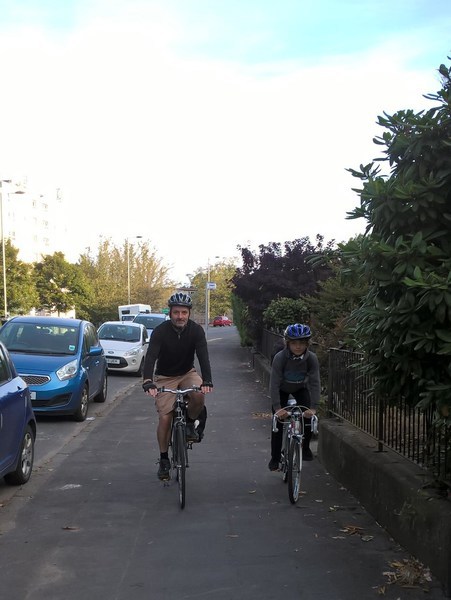
Learning from other places - active travel
Fàilte don bhlog dà-chànanach agam - Welcome to my bilingual blog
Mo thuras don obair - My commute to work
Tha mi a’fagail an taighe air rothair mu 8:20 sa mhadainn agus mo mhac as òige comhla rium. Tha sinn a’ dol sios Rathad Dhùn Bhreatainn, tionndadh gu ruige Abhainn Chluaidh, leantainn air an t-slighe rothaireachd airson greis, tionndadh gu ruige Sràid Earra-Ghàidheal agus a’tighinn dheth aig Sràid Bherkeley far a bheil Sgoil Ghàidhlig Ghlaschu (15 mionaidean). An dèidh sin tha mi a’geàrradh sios don abhainn a rithist agus a’ leantainn na-h’aibhne tro Raon Ghlaschu agus air adhart gu Baile na Drochaid (mu 35 mionaidean). Deagh eacarsaich agus gu math taitneach air na làithean tioram socair mar a tha air a bhith againn o chionn ghoirid.
If you are not a Gaelic speaker you haven’t missed too much, as I have a similar commute to several other colleagues who cycle from the west of the city to Bridgeton. My route is about 5 miles, mainly along the River Clyde and involves cycling on a mix of dedicated off-road cycle paths and main roads. On the first part of the route I cycle with my youngest son to get to his school on Berkeley Street.
So would I be happy with him cycling on his own?
Not really, because despite the fact it is good exercise, the route is mainly off-road and cycling is the quickest way to get to his school (and my office), the road sections are busy and involve tricky junctions.
This really illustrates a key issue that needs addressed in Glasgow. If we want more children to cycle to school and for other journeys, then we need a truly integrated network of safe routes. Our route which includes right turns onto and off two of the busy main roads at peak commuting time is not what I would describe as a safe route to school. And in many respects our commute to school is easier than it is to many other schools in Glasgow.
Cycle training for children (and adults) is certainly important, but if we want more schoolchildren cycling then we need to invest in better, safer routes for both walking and cycling.
Learning from other places
Scotland and the UK in general are behind the curve in terms of investment in infrastructure for active travel, but there is no shortage of examples from other places that we can learn from. I would like to discuss the findings from a recent study of the impact of cycling in the Netherlands.
This study estimated that cycling prevents about 6,500 deaths each year in the country and that Dutch people have half-a-year-longer life expectancy because of cycling. These health benefits correspond to more than 3% of the Dutch gross domestic product.
But how does these health benefits compare with other measures?
The 6,500 deaths that are prevented in the Netherlands annually as a result of cycling is an impressive figure when compared with the population health effects of other preventive measures. Another study (Machenbach et al.) showed that the 22 new preventive interventions introduced in the Netherlands between 1970 and 2010, such as tobacco control, cancer screening and road safety measures, altogether prevent about 16,000 deaths per year.
And how do the costs of investment in cycling compare with the benefits?
The authors point out that compared with the capital investments by all levels of Dutch government in road and parking infrastructure for cycling of almost €0.5 billion per year over the last decades, the annual benefits of €19 billion are much higher than the annual costs. They also note that their results are likely underestimate the total benefits, as the health benefits are based solely on reduced mortality and not for prevented morbidity and exclude wider economic benefits, such as reduced traffic congestion.
Does cycling have potential benefits across the whole population?
The Dutch study is limited to adults. There were estimated health benefits across all age groups from 20-90 year olds, but interestingly the greatest benefits in terms of predicted increases in life expectancy were among people aged 65 or over. In large part this was because levels of cycling rise with age in the Netherlands, reaching a peak among people aged 65 to 69 years before reducing significantly above 80.
What is the relevance to Glasgow or Scotland?
With around 1.6% of people cycling to work or study in Scotland (in 2011), clearly level s of cycling are much lower than in the Netherlands. Nevertheless, even with a low base of cycling we can observe health benefits. Using a similar HEAT analysis, the GCPH demonstrated that the health economic benefits accruing from cycle trips into and out of Glasgow city centre in 2012 was over £4 million. Both studies point to the potential health and economic benefits for Glasgow and for Scotland if everyday cycling levels can be increased, but to do this will need political commitment and significantly increased infrastructure sustained over decades.
A network of safe infrastructure has the potential to expand not only the number of people cycling in the population in general but is likely to encourage more older cyclists. In the Dutch study, the elderly – the group among whom the largest health and economic benefits were achieved – indicated a preference for separate bicycle paths.
Investing in safer cycling infrastructure would enable children like my son to get to school without supervision and would help instil a cycling culture in his generation, benefiting their health and ultimately benefiting the economy. The example of the Dutch also shows that with the right support and investment, cycling can be a lifelong activity.
